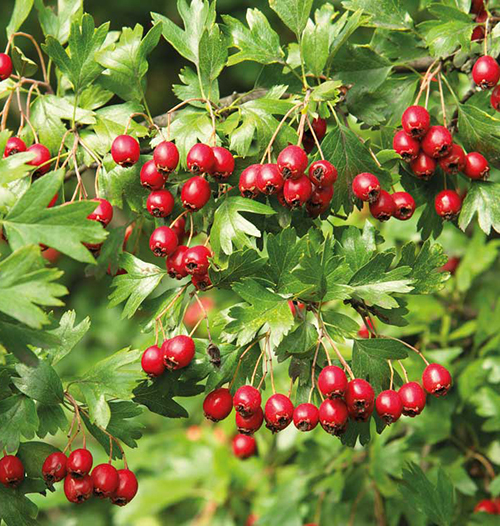
Hawtfrom (Crataegus Monogyna)
A European shrub, its flowers and berries contain many active flavonoid compounds. Infusions, or a few drops of tincture, are widely used in Europe in the treatment of heart disorders (particularly those of nervous origin), insomnia and ypertension. Extracts of hawthorn dilate and relax coronary vessels, reducing blood pressure and improving blood supply to the heart, and are therefore beneficial in the prevention and treatment of angina pectoris. The reddish-blue colouring of hawthorn berries is a pigment rich in anthocyanidins and proanthocyanidins. These flavonoids are potent antioxidants; they also stabilize cell membranes and fight infection. Available at health food stores and incorporated in formulas.
HDL (High Density Lipoproteins)
A beneficial, ‘friendly’ form of cholesterol carrier which transports cholesterol to the liver for metabolism and excretion from the body. Thus, HDL prevents the build up of cholesterol deposits in the arteries, which is the cause of atherosclerosis and heart disease.
Hemi Cellulose
Hemi cellulose is an indigestible fibre that absorbs water and expands in the digestive tract. It promotes bowel. Movements and can help to prevent constipation and promote weight loss. It is also useful in the prevention of colon cancer by its action in reducing cancer-causing compounds in the digestive tract. One of its chief sources is oat bran, but it is also found in other whole grains, fruits and vegetables, such as apples, bananas, pears, beans, corn and peppers.
Histidine
A non-essential amino acid that is found abundantly in cereals. Many people are deficient in histidine. It is a precursor of histamine, which stimulates cell growth and reproduction and is very versatile in its actions, from promoting wound healing to stimulating hair growth. As a histamine precursor, histidine has a relaxing effect and can help calm anxiety feelings. It also increases gastric juices and thus prevents indigestion and ulcers. Histidine can also dispel frigidity in women and, in sufficient quantities, intensify orgasm. Available at health food stores as a supplement.
HMB (Beta-Hydroxy-Beta-Methylbutyrate)
HMB is an exciting new food supplement which has been found to improve both health and appearance. It is not a steroid or a drug, but a natural chemical that is made in the body as a metabolite of the essential amino acid leucine. It is also present in small amounts in both vegetable and Animal foods. HMB is a natural component of mother’s milk, which underlines its nutritive role. Recent studies have shown that HMB helps to strengthen the immune system, lower high cholesterol levels, counteract stress and build strong muscles. In addition, studies with bodybuilders have shown that HMB can increase gains in muscle size and strength by up to 50 per cent. It has also been found to contribute to weight loss. In several studies, HMB has been shown to reduce body fat and promote leaner body mass. One researcher has commented that it seems as though ‘HMB helps melt body fat’ It is estimated that 0.25-1 g of HMB is produced daily by the body, depending on the protein intake. Alfalfa and some fish are among the richest sources. A daily supplement of 1-2 g is considered normal to obtain reasonable results, and 3 g a day is recommended for athletes on intensive programmes. Since it is a component of breast milk, HMB is considered to be a safe supplement.
Homocysteine
High levels of hazardous, pro-oxidant homosycteine were recently correlated to an increased risk of atherosclerosis, heart attack, osteoporosis and other diseases, creating great concern among health conscious people. In fact, homocysteine is an amino acid that is produced in the bodyas a metabolic by-product of methionine, an essential amino acid found in protein foods. In a healthy body, methionine is broken down to the toxic homocysteine, and then, with the help of vitamin B6 and folic acid, it is converted to cysteine and the non-toxic antioxidant citation, or back to methionine with the help ofB12. When there is a deficiency of vitamins B6, B12 and folic acid however, the homocysteine is not converted to cysteine but instead attacks blood vessel walls and does free radical damage to arteries. It is also linked to birth defects, such as spina bifida, which arises from defective closure of the neural tube during early pregnancy. Supplementing the diet with vitamins B6, B12 and folic acid can protect against the ravages of homocysteine. So does eating more raw green vegetables and reducing the intake of animal protein and saturated fat. Smoking and the contraceptive pill should be eliminated. Methylamine, adding a CH3 group, was recently found to be a great protector, by converting homocysteine to methionine. Furthermore, methylamine was also found to slow down ageing. And indeed, one such ethylating compound, trimethylglycine (TMG), is now available in health food stores in capsules and in homocysteine formulas.
Honey
Raw untreated honey is a good substitute for sugar and, in fact, is sweeter than sugar and is absorbed more quickly. The colour and flavour of honey vary according to the origin of its flowers and nectar. The sweetness of honey is a combination of simple sugars: glucose, fructose, maltose and sucrose. In addition to its sugar content, it containsthe B vitamins and some minerals and enzymes, and it does not upset the mineral balance as refined sugar does. Honey has been used therapeutically for centuries, traditionally to treat sore throats and coughs, stomach ulcers, canker sores of the mouth and lips, high blood pressure and constipation. It also has a harmonizing and calming effect. Externally, it can be applied to wounds and burns
HOP (Humulus Lupulus)
A perennial climbing vine found wild, it is cultivated mainly for its flowers which are used in beer making. These secrete luculent which gives beer its bitterness and aroma. Hops are a mild diuretic and have a strong sedative action. Infusions of the dried herb have a calming effect on the nervous system and are good for stress, restlessness and insomnia. A tea prepared from hops will improve the appetite, strengthen digestion, cleanse the blood, stimulate bile secretion, and is also said to eliminate intestinal worms. Usually, no more than one cup of the tea or infusion per day is recommended. Hops are available at grocers and are also available in some health food stores in capsule form
Caution: It is important not to exceed the dosage on the label of the capsules
Horse Chestnut (Aesculus Hippocastanum)
A tall deciduous tree native to Europe, North America and Asia. The seeds, which are contained in large leathery, capsules, known as ‘conkers’ in the UK and as ‘buckeyes’ in the USA, have traditionally been used in folk medicine for centuries to treat circulatory disorders such as varicose veinsAnd haemorrhoids. Horse chestnuts were imported from Persia by the Turks who used it to treat bruises in horses, hence the name. The seeds contain asking, a complex mixture of triterpenoid saponin glycosides, which has strong and antinflammatory-oedema properties. Recent studies have confirmed the horse chestnuts ability to improve circulation and reduce fragility of blood vessel walls. A study reported in 1996 in showed that horse chestnut extract was almost as effective as compression stockings for patients with venous insufficiency. New studies with aescin taken orally confirmed its ability to assist in the treatment of varicose veins, thrombophlebitis and a heavy feeling in the legs. Externally, aescin can also help in the treatment of bruises. Horse chestnut capsules are increasingly available in health food stores in potencies of 150-250 mg per capsule. They are made from an alcoholic extract of the seeds, which is dried and standardized to a concentration of 16-22 per cent aescin. Some formulas also include butcher’s broom, ginger root and rutin for a combined effect.
Caution: Horse chestnut seeds can cause poisoning if eaten in sufficient amounts. It is safer to use the standardized capsules
Horseradish (Armoracia Rusticana)
Valued for the pungent effect of its long, white root, horseradish is put to good use both as a flavouring and as a medicinal agent, especially in Japan. Horseradish contains mustard oil (allylisothiocyanate), which is in fact an irritant. It alleviates colds, snotty noses and sinusitis by promoting nasal discharge and releasing phlegm from lungs.Horseradish is available as a whole fresh root, which can be kept fresh in the refrigerator for lengthy periods
Horsetail (Equisetum Arvense)
A tall herb with a cane-like appearance, it is found wild in Europe and is also cultivated. Horsetail leaves are one of the richest sources of silicon and can be used as an ingredient in silica supplements. As such, horsetail can increase calcium absorption, strengthen bones, teeth and hair, and promote a healthy and attractive complexion. Horsetail also contains other minerals such as calcium, copper and zinc, and is used as a diuretic and in the treatment of kidney stones. Horsetail is available in tablets and capsule
Huperzine
Huperzine A is extracted from Huperzia serrata, a type of moss also called Qian Ceng Ta. The whole herb has been traditionally used in China for thousands of years to treat fever and inflammation. Recent studies show however, that it may help enhance short-term memory and protect the brain from normal ageing damage. Available at health food stores
Hyssop (Hyssopus Officinaus)
Hyssop’s leaves are astringent and can be used to relieve flatulence and stimulate menstruation. Infusions of the leaves are also used to improve digestion, suppress coughs and relieve intestinal congestion. Decoctions are said to relieve inflammation. Available from health food stores and herbalists.
Caution: Do not use for periods longer than a few weeks.
